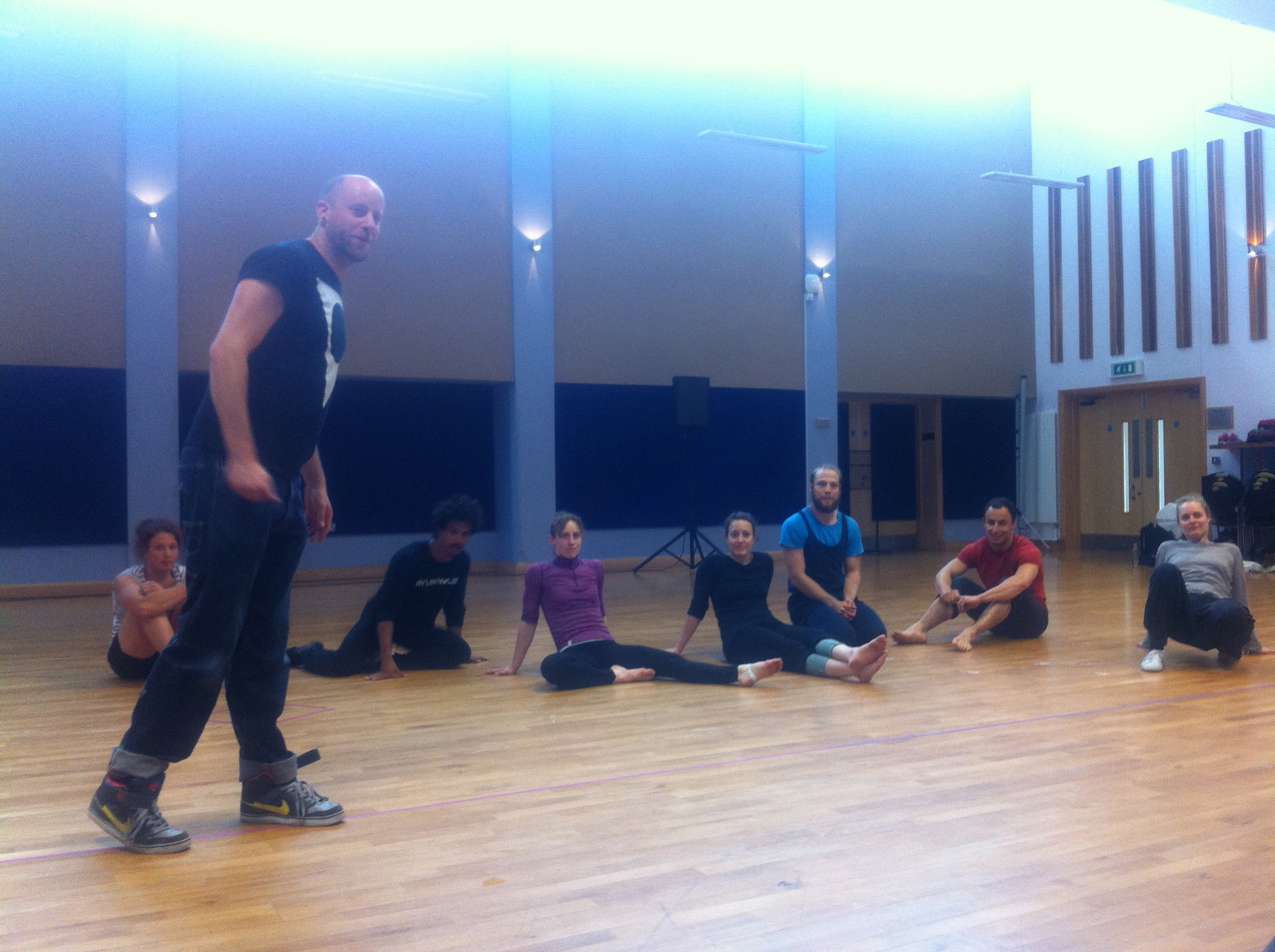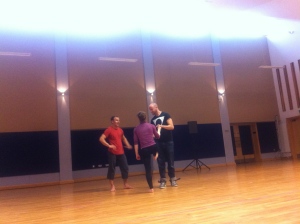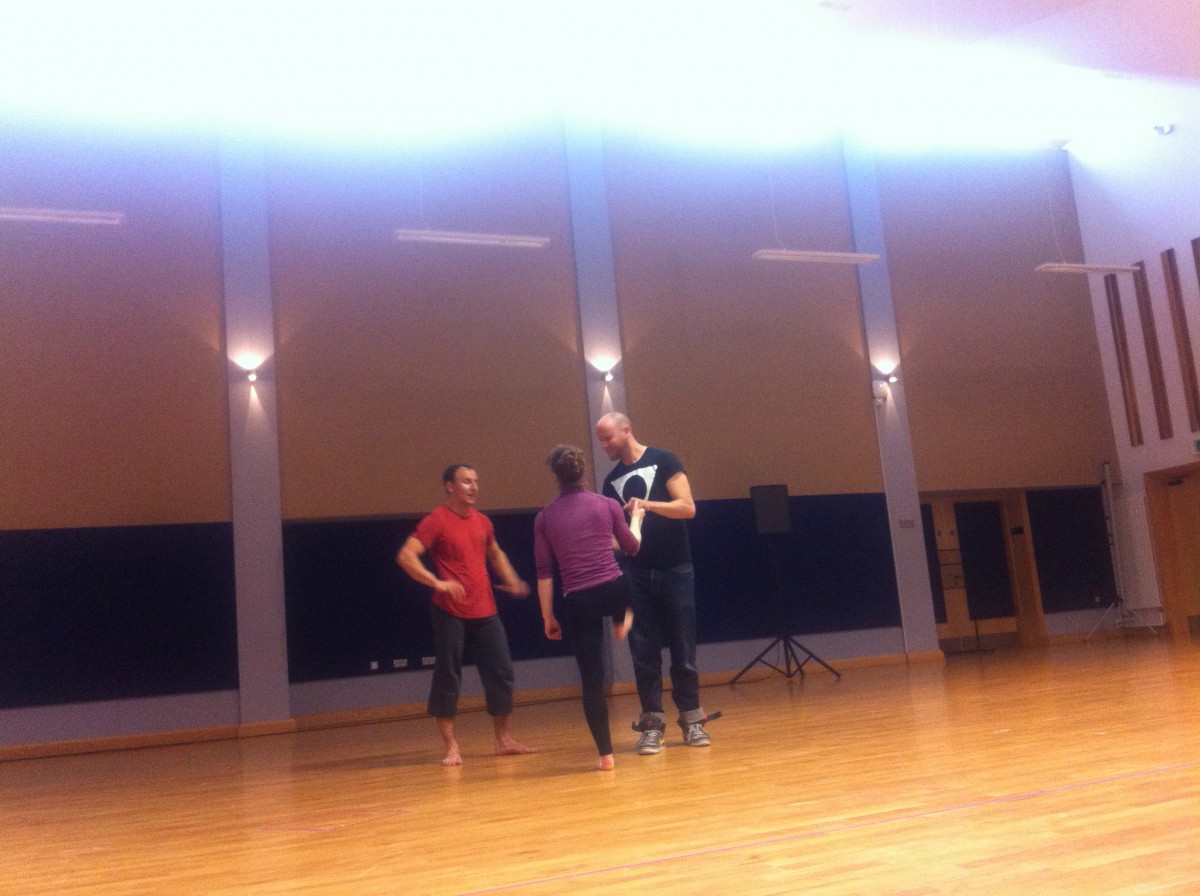Lakeside Theatre, Nottingham; 24th May 2014
The rig for Square Peg Circus‘ current tour of Rime, – an acrobatic interpretation of Samuel Taylor Coleridge’s famous poem, The Rime of the Ancient Mariner – is suitable for indoor and outdoor performance; but not so the English weather. Today, the sodden ground outside Nottingham’s Lakeside Theatre is unsafe for the 7 performers to work on. Luckily, there’s a contingency plan – the audience who haven’t heard news of the cancelled show are ushered into a spacious dance studio to watch Tim Lenkiewicz direct an open rehearsal (with refunds/replacement tickets on offer as well).

As we’re led into the studio, the performers are already working together and warming up in casual sportswear and bare feet, while Lenkiewicz lays tape along the floor to demarcate boundaries (we later discover the main purpose of this rehearsal is to prepare for the more limited dimensions of Rime’s next stand in Salisbury). The activity is all very watchable in itself and, as we have not been told what to expect other than ‘something informal’, I wonder if they are going to continue tossing each other around as if we were not in the room, practising their banquines behind a fourth wall.
In fact, as Lenkiewicz finishes pacing out his floor plan, the performers scatter to collect bottles of water and socks, and come to sit in a rough line facing us. Lighting Designer Will Ingham switches off the sea-shanty flavoured backing track, and we get down to introductions.

The performing company is made up of Jean-Daniel Broussé, Tomos James, and Rosamond Martin, who started Square Peg as part of the original team in 2009, and four new-comers who joined the troupe in January. Antonio Harris was already known to the company, having trained at Circus Space, and fortuitous circumstances bought Nikki Rummer on board when she and Broussé discovered a natural working dynamic after both had lost their previous acrobatic partners. Hege Eriksdätter and Isabelle Schuster were the successful candidates for the remaining positions – out of 300 initial applicants – following the submission of video reels and participation in two workshop auditions. Rime was initially produced in 2012, and Lenkiewicz was keen to cast artists who could match the style and working rhythms already established by the aerialists and acrobats who had created the original.
Lenkiewicz explains that today’s rehearsal is ‘not the kind where we make new things, but the kind where we check the things we have are in good shape, and working the way they should.‘ Rime’s physical movement is incorporated within a theatrical narrative, and the company follow the same etiquette that actors would use when rehearsing stage combat fight scenes. First, the tricks are practised technically one after another without any extraneous performance context; once the acrobats are happy with the ensemble skills element, they then run the scene in its entirety.
The first scene the company are going to look at this afternoon is the opening of the show, introducing James as the narrator, and incorporating ensemble choreography by Martin Corri that illustrates the preparations of a ship’s crew for sail. With the energetic lifts and spins, a three-high tower and a special trick they call ‘rainbows’, I understand why the company refer to this scene as ‘the super sailors’.
Part of the inner workings revealed through open-rehearsal is the intimate private language used to refer to elements of the show. As segments of scenes are reworked, the artists check with each other, ‘Are we going from the Boom Cue?’ ‘No, from the Apple Cue’; they skip ‘the good picnic’ and go straight for ‘the bad picnic’. I find these teasing suggestions whet my appetite far more than polished video trailers, and I especially enjoy the commentary from the cast as they, earthbound, mark through their aerial routines. ‘We’re hanging from the bar’; ‘I’m at the top of the pole’. My imagination is engaged.

The unique rig that forms the centre-piece of Rime is an invisible presence during today’s snapshot rehearsal, as it currently stands outside hoping for dryer weather tomorrow. The bare aluminium structure reveals little of how it will transform over the course of the show; the truss arch and two chinese poles will be supplemented by ropes, sails and silks, and the cross-beam pole will be moved up and down to become a balance bar, static aerial structure and ship’s rigging. I wonder if there are other surprises that I haven’t picked up on yet…
When the sweating artists finish the scene, Martin comments on how tiring the work is, even without the equipment-based tricks. But this is rehearsal, and they now have to repeat the section – after notes from Lenkiewicz. His director’s eye is able to see the big picture more clearly, accustomed to visualising the absent structural elements, and with a determined aim in mind. While the open-air playing space in Nottingham offers a generous area to work in, Salisbury Playhouse‘s indoor stage is more limited, and this means that timings of certain movements must be adjusted in order to co-ordinate all seven performers. To ensure all the pieces come together at the correct time, the company re-evaluate the number of musical counts they need to keep the tightness Lenkiewicz demands in this new reduced space. For me, it is great to be able to see the same scene repeated – there is a lot going on, and I am able to notice things I missed the first time, such as the mimed aerial elements down at ground level.

During a standard rehearsal, of course, there are no audience responses to interfere with concentration or to worry about. Today’s crowd, initially expecting to see a full production, are keen to applaud at every opportunity, and I ask if this is off-putting. ‘It’s nice’, grins Harris, as the others all nod enthusiastically. Perhaps more disturbing may be the toddler who is vocal and exuberant in her appreciation, calling the acrobats to ‘Go!’, and then applauding her own power when they seemingly obey, flinging themselves through the air into waiting arms. Lenkiewicz shoots her regular glances, but she is not to be deterred. Good practise, I think to myself, for outdoor public performance where the traditional codes of theatre etiquette rarely apply. In another amusing moment when the rehearsal and performance worlds collide, Broussé unthinkingly utters the s-word as he tries to nail a particular move. Now we’re all grinning, reminded that these super-talented individuals are human just like us.
The circus performers seem far less inhibited than regular actors usually are in similar situations. Perhaps because there is a precise physical achievement to focus on – a somersault, a balance – there is less room to be self-conscious. In the scenes we watch today, all the text is performed by James, who trained at drama school before joining the circus. The story is laid out for us partly in new writing, and partly in Coleridge’s own words – for the first time I realise where the phrase ‘water, water, everywhere, nor any drop to drink’ comes from.
As the ship’s crew lie starving and dying of thirst, a lone apple rolls into sight; the ensuing chaos is the next scene we watch brought to life. After an initial run-through, Lenkiewicz again pulls apart sections that need to be tightened. ‘Go for the clarity, and find the meaning in all the little bits’. As he focuses his attention onto a sequence of lifts between Broussé and Eriksdätter, Martin comments ‘I’ve never seen that before, is that in the show?’ When the performers are working simultaneously, they aren’t always aware of the exact nature of their colleagues’ roles, and these rehearsals offer an opportunity for them to get a greater feel for the overall picture.
The elements of circus technique are integrated here as a mode of storytelling in their own right. ‘It’s not gratuitous, it’s an essential part’, explains Producer Flora Herberich, who recognises that all too often theatre companies add circus elements as a visual gimmick, or circus troupes tack on loose story lines to existing acts. Square Peg have developed Rime holistically and, after watching their rehearsal, I am excited to see the production in a way that I hadn’t been before, burnt by incomplete circus-theatre hybrids in the past.

We are also shown an acrobalance duet between Broussé and Rummer, who portray the bride and bridegroom at the wedding where the Ancient Mariner relates his tale. The pushing and pulling between them, emotionally and physically, is intended to draw parallels with the Mariner’s treatment of the albatross, and contains some surprising and beautiful moments of choreography. Lenkiewicz isolates moments where the story slips and becomes merely a sequence of moves, honing in on the intentions behind each hold. ‘This is how you clean up details, make it clearer.’
We end the afternoon with a question and answer session, where audience members enquire about company history, and ways the performers protect themselves while working in such an intense physical way. Eating well and resting properly are essential, and I notice James slipping on a sweatshirt as his body starts to cool down. The artists also talk about skill-specific conditioning and training exercises that differ depending on speciality. I wonder about costuming, and Herberich shares some of her production photographs with me; the design embraces the idea of the frontier, through both 18th Century maritime aesthetics, and 19th Century aeronautical imagery. As Lenkiewicz clarifies,
Circus exists in the space between earth and sky. In this show, we occupy the space between sea and sky.
And, of course the exciting realm between classical circus and theatre.
The Square Peg Circus website has some great blog posts of their own about the creation process of Rime, and you’ll also find further details of their tour. I look forward, now more than ever, to catching their show later in the season.





[…] Rime, whose high rig commands attention in the centre of the park. The weather is on their side today, and the gathered crowds are happy to sit and sun themselves on the grass for an hour to take in […]
[…] ‘Make like a juggler and drop it’). As I sit, I’m joined by Tim Lenkiewicz of Square Peg, who just happens to have popped in to meet a friend. Before I know it, I’m reading out […]